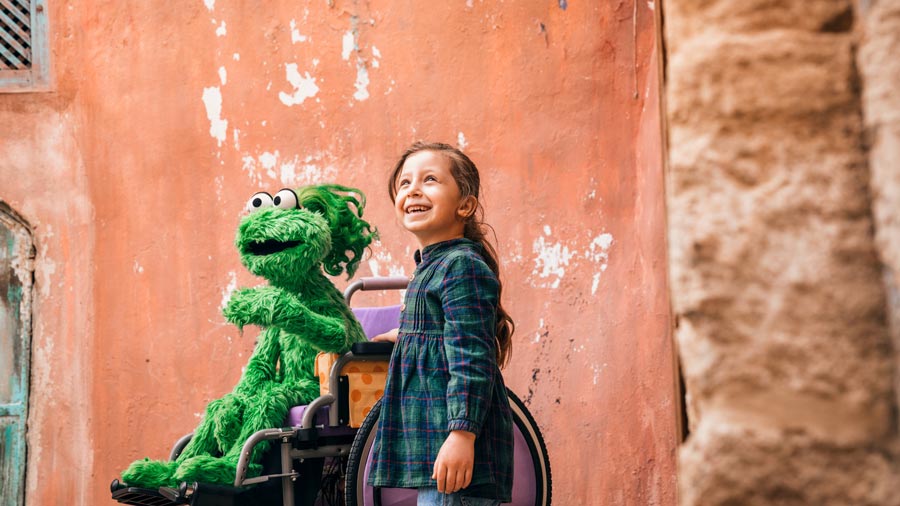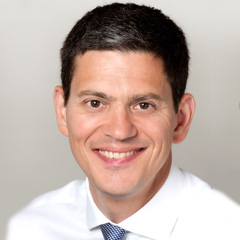Sherrie Westin of Sesame Workshop and David Miliband of International Rescue Committee share that direct services and educational media deliver substantial preschool learning gains in crisis contexts.
When Sesame Workshop and the International Rescue Committee first launched Ahlan Simsim five years ago—with the historic support of MacArthur’s inaugural 100&Change award—our goal was to address a grave humanitarian crisis: a generation of children raised amidst conflict in Syria and the surrounding region with limited access to early childhood learning and development opportunities. Today, as the largest early childhood intervention in the history of humanitarian response, Ahlan Simsim (“Welcome Sesame” in Arabic) has delivered those critical opportunities to more than a million children and caregivers through direct support for families and over 23 million children through an award-winning locally produced version of Sesame Street.

Ameera and a young child in Saida, Lebanon. Photo Credit: Ryan Heffernan/Sesame Workshop.
Ahlan Simsim, though, has another goal: sharing our research and learnings, so that our work can have a ripple effect that helps children affected by crisis and conflict around the world. A commitment to research has always been at Ahlan Simsim’s core, with a robust plan built into the design with an external evaluation partner, NYU’s Global TIES for Children. By sharing the lessons learned from our program, we are laying the groundwork for others to adapt, build upon, and scale up these models for other humanitarian contexts.
Last week, NYU released the results of these landmark studies, with good news for children, families, educators, and policymakers. The findings point to Ahlan Simsim’s substantial impact on children’s learning, demonstrating the power of integrating educational media with early childhood development services—with significant implications for delivering early learning in humanitarian and other contexts where traditional in-person schooling is not possible.
Watching the Ahlan Simsim TV show in kindergarten classrooms significantly increased children’s ability to identify emotions.
An impact evaluation of our Remote Early Learning Program delivered to displaced children in Lebanon showed the incredible potential for remote preschool programs that integrate educational media into the curriculum. When the COVID-19 pandemic made in-person services all but impossible for nearly two years, we turned to mobile phones to connect families virtually and leveraged the power of mass media to reach families with Ahlan Simsim video and print materials during the crisis. When Ahlan Simsim’s in-person preschool programs were not possible, we pioneered a remote program combining engaging media with remote instruction, leveraging caregivers to support their child’s learning.
The model worked. NYU’s evaluation showed that Ahlan Simsim’s 11-week remote preschool program with educational media integrated into the curriculum produced statistically significant impacts on children’s development, particularly for literacy, numeracy, and social-emotional skills, comparable to a year of in-person preschool programs.

Grover and two young children playing a game in Saida, Lebanon. Photo Credit: Ryan Heffernan/Sesame Workshop.
Another study in Jordan found that watching the Ahlan Simsim TV show in kindergarten classrooms significantly increased children’s ability to identify emotions—particularly harder ones like fear, frustration, loneliness, and nervousness. After watching, children were also better able to apply a simple regulation and coping strategy like belly breathing. These “emotional ABCs” form a crucial foundation for all young children, but especially those who have experienced adversity. This research underscores the power of educational mass media to achieve key learning outcomes while reaching children at scale.
One young boy told his mom she had to take a deep belly breath when she was feeling overwhelmed, a coping strategy he learned from Ahlan Simsim.
In qualitative findings, we learned that for many children, watching Ahlan Simsim was a highlight of their day. When the show was played in classrooms, children would jump up and down when the Ahlan Simsim theme song played, even grabbing their teacher’s hands to dance together. One child, who had been home sick earlier in the day, asked to come to school for the end of class just so they could watch an episode of Ahlan Simsim.
Taken together, these studies demonstrate just how effective Ahlan Simsim’s unique combination of educational media and early childhood services can be, laying the groundwork for others to adapt and scale similar programs. The findings demonstrate that flexible, user-centered, evidence-based, and culturally relevant early childhood services integrated with media content can support a wide range of child development outcomes, strengthen children’s learning at school and at home, and support lifelong positive outcomes.
This is echoed in the stories of children experiencing the program.
One young boy told his mom she had to take a deep belly breath when she was feeling overwhelmed, a coping strategy he learned from Ahlan Simsim Muppets Basma and Jad. In Jordan, classmates who at first struggled to relate to a young girl who used a wheelchair were more welcoming and helpful after watching an episode where the characters adapted a game to include Ameera, a friend who similarly used a wheelchair. In the remote preschool program in Lebanon, caregivers developed a new appreciation for the importance of learning through play; their positive interactions with their children increased, and the program may have even decreased rates of physical discipline.
Five years ago, we came together with the aim of setting a new standard for early childhood care and development for children affected by conflict and crisis. With this new research, we now know that we can deliver critical early learning opportunities to millions of children at scale, with proven results. Our task now is to leverage our learnings to catalyze lasting change for all children affected by crisis around the world, wherever they may be.
To read the new studies, visit NYU’s Global TIES for Children.





